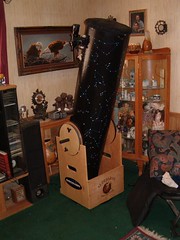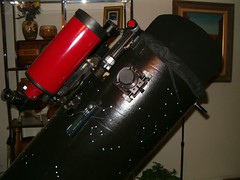
Here is a quick rundown of my scope. When I first put the telescope together, I found that both the primary and secondary mirrors needed to be collimated. There are four thumbscrews on the secondary mirror, and I found them easy to grip and manage. I was able to adjust the secondary mirror with ease. Apart from not requiring a wrench to make the adjustments, having four screws on the PDHQ makes maneuvering the mirror easier in that they move in simple up/down and left/right directions. The primary mirror is center marked to aid in collimation. There are three thumbscrews on the back of the primary mirror cell, and though they are somewhat stiff, they do turn with little difficulty to achieve proper collimation. The focuser is a Crayford focuser made by JMI, and it is designed to allow smoother motion and more precise control than more traditional rack-and-pinion focusers. There are no jerky gears to be found, and instead there are four small metal wheels which allow the mechanism to glide in and out to help achieve better precision. The 2-inch focuser includes an adaptor for using eyepieces of 1.25-inch barrel diameter. The exciting time came when I took my new telescope out under the night sky for the first time. I knew I was going to get a significant improvement in the views over what I had seen in the SN8. The 12.5-inch primary mirror collects 2.44 times as much light as the SN8's, which computes to an increase of 0.97 limiting magnitude. I set up well before sunset to allow for any unexpected last-minute adjustments. After I collimated the mirrors and aligned the finderscope and Telrad, I sat back and waited for darkness to fall. Then I took the PDHQ on its first sky tour, during which I observed a whole variety of targets in order to get a feel for how they all appear. One thing that struck me early on is that Discovery's optics are absolute top-notch! I got a very crisp, sharp image with almost no aberrations other than the diffraction spikes that result from the spider holding the secondary mirror. Because the 1587mm focal length is longer than the 812mm of the SN8, each eyepiece I used produced a noticeably larger image in the PDHQ. But at the same time, I was able to use higher magnifications more regularly without degrading the image, which is the result of the extra aperture at work. I rarely used my highest magnification 6.4mm Plössl eyepiece with my SN8, but I found plenty of good opportunities to use it on the PDHQ, particularly when viewing globular clusters. The mechanics are for the most part very good. Of the deep-sky objects I have seen so far, globular clusters have impressed me the most in the increased aperture. Brighter ones in particular such as M13,M5, and M22 deliver really stunning views in magnifications between 150X and 250X, as hundreds of stars become easily resolvable within and surrounding their cores. Planetary nebulae also look much better in the larger optics. Classic examples like the Ring (M57) and Dumbbell (M27) are very bright, and they show their distinctive shapes superbly. The larger aperture also brings out more color in such objects, as NGC 6572 provides a vivid blue-green appearance. Emission nebulae are another winner, especially when used in conjunction with a narrowband filter. I was able to see more detail in the Lagoon (M8) and Swan (M17) nebulae than before. Open clusters like M6, M7, and IC 4756 also benefit in the PDHQ, where in addition to the aperture making the stars brighter and more colorful they also take advantage of the precise control of the Crayford focuser. Once I hit the right spot when adjusting the focuser, the stars appear tack-sharp! When I pointed the scope at the Wild Duck Cluster (M11), the view through the eyepiece knocked my socks off! Galaxies appear brighter too, as they reveal more of the outer sections surrounding the cores while also better emphasizing their oval shapes. I was able to put the PDHQ's improved resolution to the test by observing a few tight double-stars that didn't always easily split in the SN8. Epsilon Lyrae and Nu Scorpii are two good examples, and those pairs did split with greater ease in the larger aperture.

My 4" Mak Piggybacked to my 12.5"dob (pictured above)
One of the scopes I am asked about the most is my Orion 4" maksutov. I use this scope primarily for splitting double stars which it does superbly plus planetary, and luner viewing which this scope just does an awesome job. The OTA is well made, largely constructed from metal and nicely finished in burgundy. The Apex comes with a 45° diagonal that provides a correctly-oriented field of view . I keep a good quality Stellarvue Dielectric 99% star diagonal in the case along with the one supplied with the Apex. In my opinion this is an essential accessory if this scope is to be used at higher magnifications, particularly for planetary use. Optically the scope is superb and I can't really fault it in that respect. There is however a problem with internal baffling or rather lack of it. This is only noticeable when observing close to bright objects such as the moon, but it must inevitably reduce contrast. The source of the problem is off axis light reflecting off the side of the baffle tube - a common problem with all types of Cassegrain and by no means unique to this scope. This scope is not perfect but then how many telescopes are? For a scope that measures just under 300mm (12") in length this a real performer. I have had some really nice views of the planets, especially Saturn which I caught on a particularly good night. It also makes a great Lunar scope. In terms of image quality it easily handles 200x magnification on a good night. The limiting factor with this scope seems to be light grasp rather than resolution. I have pushed this scope to 325x and it has still produced reasonably sharp images - it simply runs out of light long before that point. One thing I really like on this scope is the focus control, it is very smooth, my scope shows no noticeable image shift and allows fine adjustments to be made with ease. This is a 102mm telescope and performs exactly as it should for the aperture. Overall I'm very pleased with this scope.







No comments:
Post a Comment